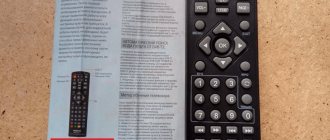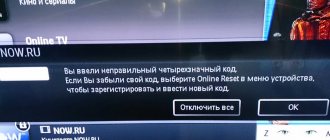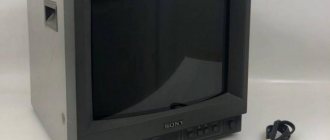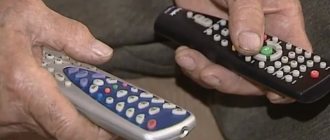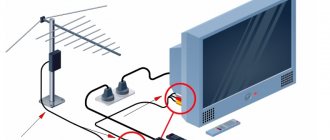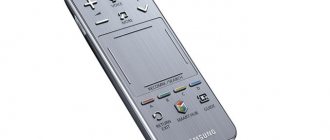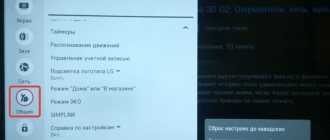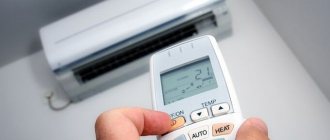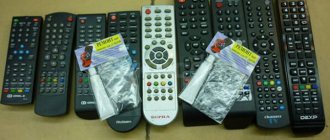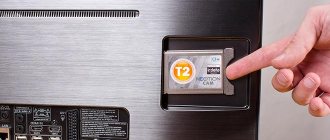Television is an easy way to learn new information. TV makes it possible to watch not only entertaining programs, but also educational ones. A TV remote control is the key to watching interesting films, cartoons and various programs, as they say, without leaving the couch.
A remote control is a device for changing channels, adjusting the volume; it can be used to control not only a TV, but also audio recorders, an air conditioner, a vacuum cleaner, and even entire robots. The remote control is a complex device, it has come a long way to end up in the form we are familiar with.
This is what the first remotes for old TVs looked like:
Often, remote controls operate using a modulated infrared signal, but bluetooth is being used more and more often, but other protocols are found and are used extremely rarely. Also, recently, connecting via WiFi has become increasingly popular.
Remote control device
A household remote control is a box with buttons on the front.
The remote control operates on batteries and sends signals in the form of infrared rays (0.75 - 1.4 microns). The wave is not recognized by a person, but is perceived by the receiving mechanism. The design contains a packaged or packaged microcircuit, which is located on a dielectric plate and filled with a polymer thermoplastic resin. The universal remote control panel has the following basic parts:
- power key, device selection;
- volume control and channel switching, date and time settings;
- numeric keys for entering numbers;
- programming buttons;
- joysticks for menu navigation;
- keys, the purpose of which is chosen by the user independently;
- LCD or touch screen showing current information.
Devices with many functions require a complex system with wave frequency regulation, which also protects the channel from interference and encodes the commands being sent. Digital conversion is used by the remote control chip and decoding by the receiver.
Comfort in use
The third important criterion is the general feeling of comfort that occurs when working with the device. The device should fit comfortably in the hand, the location of the buttons should be such that each of them can be quickly reached. The concept of comfort is individual for each person.
In order not to make a mistake with your purchase, you can look at reviews of the device model you are interested in on the Internet, read information about it on various forums and websites, or just hold it in your hand before purchasing.
Operating principle of the remote control
More often, devices use one frequency modulation (radiation from an LED element), to which the receiver and remote control are tuned. Frequency values with constant amplitude are usually unchanged - these are 36, 38 or 40 kHz (Button, Canon, Pro Black). 56 kHz indicators are rarely used (Sharp, Runva, Doorhan). Bang & Olufsen products operate at 455 kHz, which is a rare characteristic.
If the frequency of the receiver and transmitter do not match, the remote control will work, but its sensitivity will decrease. Several modulated bursts of pulses create a coded message, and the receiver contains a demodulator, a filter circuit, and a frequency detector.
Previously, only the basic commands of the controlled device were placed on the remote control; most of the controls were located on the body of the household appliance. The situation has changed: ventilation, gates, lighting, and traffic light equipment can only be controlled using a remote device.
Types of wireless remote controls
Built-in remote control
The devices are powered by 2 - 4 removable batteries of type AA, AAA, less commonly used 9 V Krona batteries. The IR LED requires 2.5 volts to operate, so several elements are required to ensure the remote control level. Experts recommend alkaline or salt batteries.
Depending on the type of power supply, there are remote controls:
- autonomous;
- devices powered from a 220 V electrical network or with a 360 V converter.
They produce portable devices that are often used in everyday life for wireless control of lamps, chandeliers, gate opening, tail lift operation, and other switches. The built-in IR remote control is installed to control complex smart home systems or installed in industrial complexes to control, for example, a crane.
Control devices are classified according to functionality:
- with a limited number of teams;
- with a choice of the number of orders (universal option, for example brand ABCD);
- with the ability to train a set of signals (trainable models, for example, DC V).
ABCD remote control
DC V remote control
Communication with the controlled equipment is established mechanically or wired, using a radio channel, WI-FI, ultrasonic and infrared methods. The Trodfrey driver controls the light in a home remote control, and Wireless USB replaces standard wired transmissions.
Smart home equipment for apartments: light control via the Internet
The availability of this method is based on the fact that the remote lighting control scheme is based on the use of devices that already work in most of our apartments.
State-owned information technology companies have long provided most residents with unlimited Internet that operates around the clock.
I purchased smart home equipment for an apartment in China from Sonoff. Next I show how the remote lighting control scheme works via the Internet from a smartphone.
The kit includes a Sonoff smart switch and a small key fob remote control.
In principle, all work via the Internet occurs through a smartphone, and the remote control is only needed to switch the lights inside the apartment. Although even in this case you can get by with your mobile phone.
It’s just convenient to keep the key fob remote control in one place; all family members, including children, can use it. In addition, it works regardless of the presence of WiFi.
Now I do not intend to fully describe the settings of the smartphone and the connection of its circuit to the smart switch, but will focus on the difficulty that I had to face when installing the module in the old installation box.
My apartment is located in a multi-storey panel building built in Soviet times. For electrical wiring, the factory immediately created channels for laying cables.
They are located at arbitrary angles, often in the most inconvenient places for installation: literally in the recess at the junction of the wall and the ceiling slab. A channel for switches or socket groups runs downwards from it obliquely.
The old switch connection diagram is based on breaking only the phase wire. Therefore, the zero potential is not drawn there.
However, a Sonoff smart switch without zero potential will not work. I had to pull it there through an inclined channel.
When I removed the old switch housing, I saw an ordinary aluminum noodle - 2 wires. Then he climbed into the junction box, if that’s what you can call the place where the slabs join, which was covered with small gravel with scraps of newspapers and pieces of concrete.
I saw a tangle of twisted wires and black electrical tape. The voltage indicator and digital multimeter helped quickly understand the purpose of each connection.
It turned out to be a problem to insert an additional core of zero potential. The crushed stone and cement dust firmly filled the entire space of the cable channel.
Even attempts to pass through this composition with a rigid steel wire were unsuccessful. And inside the room, cosmetic work was recently carried out and new wallpaper was installed. I didn't want to stir up any dirt.
I used the old trick:
- Turned off the light in the apartment panel.
- I taped a piece of copper cable with three cores to the lower end of the old two-core wire with strong electrical tape.
- I inserted pliers with long jaws into the ceiling cavity and clamped them with the top piece of aluminum noodles, because it is impossible to pull it there with your fingers.
- I began to little by little wind the wire onto the pliers and remove the debris that was coming out of the channel, afraid that it would break. But it worked out.
In this way, it was possible to pull a new cable through the littered main and remove several handfuls of small stones from it. Why were they put there? I don't have an answer to this question.
I hope that my experience will be useful to someone.
By the way, much of the equipment from Nootekhnika: Belarus also allows you to control the light remotely via the Internet from mobile devices in the same way.
Remote control diagram
An encoding method is used to distinguish the commands of the transmitting block. Before broadcasting the signal, the remote control issues one or more synchronous packets so that the touch receiver sets up the receiving circuit and synchronizes with the transmitter in phase and degree of sensitivity.
Two schemes have been developed for this purpose:
- The first system is used in the Philips remote control (in accordance with the RC5 and RC4 protocols). The sending of signal 0 is supplemented by the number 1, and sending 1 requires the addition of 0. Signal 001 arrives in the form of 010110 and is read sequentially, and a simulated packet is sent into space.
- The authors of the second encoding scheme are representatives of Sony. One is transmitted in a modulated burst, and zero means a pause. Zero transmits encoded information at the same time indicator of one.
Studies have shown that the duration of signals varies by time deviations at the level of +-10%. Transmitted packets are modulated by changing the frequency, which affects the operating range of the device.
IR signal transmitter
The IR signal transmitter, IR remote control, is most often powered by a battery or accumulator. Therefore, its consumption should be as low as possible. On the other hand, the emitted signal must be of significant power to ensure a long transmission range. Such problems, which are opposite in terms of energy costs, are successfully solved by the method of transmitting short pulse coded packets. Between transmissions, the remote control consumes virtually no energy. The task of the remote controller is to poll the keyboard buttons, encode information, modulate the reference frequency and output a signal to the emitter. Various specialized microcircuits are produced for the manufacture of remote controls, but modern general-purpose microcontrollers such as AVR or PIC can also be used for these purposes. The main requirement for such microcontrollers is the presence of a sleep mode with extremely low consumption and the ability to sense button presses in this state.
The IR signal emitter emits infrared rays under the influence of excitation current. The current to the emitter usually exceeds the capabilities of the microcontroller, so to generate the required current, a simple LED driver is installed on a single transistor. To reduce losses, when choosing a transistor, you need to pay attention to its current amplification factor - β or h21. The higher this coefficient, the higher the efficiency of the device. Modern transmitters use field-effect or CMOS transistors, the efficiency of which can be considered marginal at the frequencies used.
The above scheme is not without its drawbacks, in particular, as the battery charge level decreases, the radiation power will decrease, which will lead to a decrease in range. To reduce dependence on the supply voltage, you can use a simple current stabilizer.
Most transmitters operate at a frequency of 30 - 50 kHz. This frequency range was chosen historically when the first such devices were created. The area with the lowest level of interference was selected. In addition, restrictions on the element base were taken into account. Later, as equipment with this control method was standardized and distributed, switching to other frequencies became impractical.
In order to increase the pulse power of the transmitter, and accordingly its range, the fundamental frequency signal differs from the meander and has a duty cycle of 3 - 6. Thus, the pulse power is increased while maintaining or even reducing the average power. The pulse current of the LED is selected based on its nameplate values and can reach one or more Amperes. The pulse current in most IR remote controls does not exceed 100 mA. Moreover, since the reference frequency has a low duty cycle and the duration of the encoded message does not exceed 20-30 ms, the average current when the button is pressed does not exceed one milliampere. Increasing the LED pulse current is associated with a decrease in efficiency and a decrease in service life. Modern infrared LEDs have an efficiency of 100-200 mW of emitted energy at a current of 50 mA. The permissible average current should not exceed 10-20 mA. The LED power supply must have an RC filter, which reduces the impact of impulse noise on the microcontroller power supply. The spectrum of LEDs used for IR remote controls of most household equipment has a maximum in the region of 940 nm.
The duration of a single packet of the reference frequency for reliable reception is no less than 12-15 and no more than 200 periods. When transmitting an encoded message, the transmitter forms a preamble at the beginning, which is one or more packets of the reference frequency and allows the receiver to set the required level of gain and background. Data in an encoded package is transmitted in the form of zeros and ones, which are determined by duration or phase (the distance between adjacent packets). The total duration of the encoded message most often ranges from several bits to several tens of bytes. The order of occurrence, the beginning sign and the amount of data are determined by the format of the parcel.
How to make a remote control with your own hands
4-channel remote control circuit
The remote control is a device that can be assembled by converting a smartphone. You need to purchase infrared diodes or remove them from unnecessary remote controls (2 pieces) and a plug from old headphones. For assembly you will need sandpaper, electrical tape and superglue; the work is carried out with wire cutters and a soldering iron.
The following steps are performed for manufacturing:
- On one side, the elements of the IR diodes protruding from the sides are cleaned using sandpaper.
- The diodes are connected using superglue so that the ground side is inside.
- The legs of the diodes need to be bent and the excess protrusions removed with pliers.
- The anodes are soldered to each other using a soldering iron.
- Similar processing of the second diode is carried out;
- Both LEDs must be connected to the plug lugs without observing polarity.
- The soldering area is coated with glue and protected with insulating tape.
The connection mode is done via IR Port or WI-FI, IR Blaster. The TV modification is selected and the action is confirmed. The converted smartphone is sent to the IR receiver of the home screen, and the functions are controlled.
Scope of use of remote control
A universal remote control controls several types of consumer electronics. Such a device differs from a local device, which is sold together with a washing machine, X-box or camera. UP is sold as a separate product and purchased separately.
Different manufacturing technologies affect the final actions of the device and its cost. Remote controls control one or more units, the range of application is determined by the manufacturer. Trainable models make it possible to specify a list of coordinated equipment through programming.
In everyday life, the IR remote control works with all modern models of household appliances, is used in a complex home automation system for climate control, organizing burglary protection, opens and closes entrance openings, and adjusts the operating mode of cooking and heating units.
Advantages of remote controls
The transition to remote control provides convenience for the user, since there is no need to move around the home to turn on the lights and set the microclimate parameters in the room. In an automated system, a person can use a remote control to ensure high-quality work at home without leaving his seat.
Remote response works successfully when objects are remote from the operator, for example, when coordinating aircraft, airplanes, and cars. Beacons, repeaters, and radio communication stations are controlled at a distance and do not require the direct presence of a person.
Games like Xbox previously used a wired communication system, but the change to wireless remotes gives players more options.
Selecting a Universal Controller
To choose the right remote control controller, you need to have a rough idea of what you want to get from this device. Based on these requirements, the following criteria can be distinguished: accuracy, reliability, ease of use.
